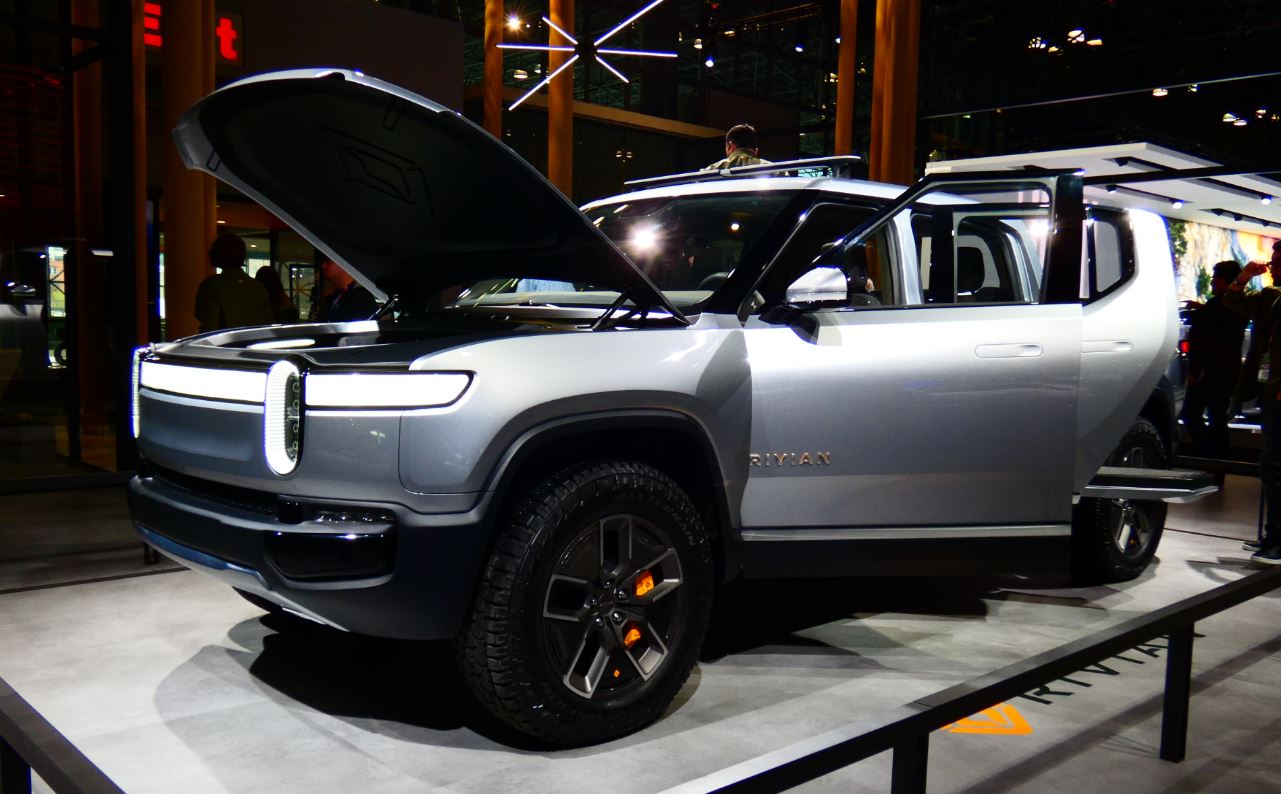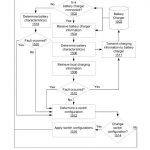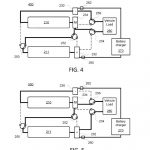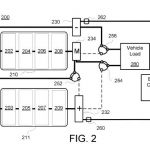

News
Rivian patent application hints at 900V fast charging capabilities
A recently published Rivian patent application titled “Configurable Battery Pack for Fast Charge” describes a method of switching between battery pack connection types to allow for both 450V and 900V fast charging without the need for specialized components. The invention was filed in both the US and internationally, and both applications just published today as US Patent Publication No. 2019/0126761 A1 and International Publication No. WO/2019/084507 A1.
Rivian’s application sets out to solve three specific issues with electric vehicle battery charging. First, increases in charging rates typically require more expensive parts that are rated for the higher current requirements. Second, electronic devices operated while a battery is charging may be impacted via increased voltage when a battery’s charging rate is increased. Finally, when a fault occurs in a battery module, a battery system often needs to be completely disconnected from any loads or the charging voltage must be changed.
The basic concept of the application purports to solve the above-referenced problems. As described, the invention claims that battery modules connected in parallel achieve a targeted maximum high voltage for an electric load (such as 450V), but when connected in series that voltage can be doubled (900V). Details of why this is advantageous are explained in the application as follows:
“A configurable battery system allows the techniques of [this invention] to be applied to an electric vehicle…to more fully utilize a battery charger’s potential [where] it is desirable to achieve a particular charging target. For example, a charging target of 150 kW at 450 V may require a current of 334 A…[and] components may need to be sourced to handle up to 400 A continuously to handle the charging….If a battery system were able to take advantage of charging at 900 V, the charging target of 150 kW could be achieved at just 167 A, which may allow for more numerous, better quality, or cheaper options for charging components. For example, a current of 167 A may allow different hardware to be used than if the current were nearer to 400 A.“
- Figure from Rivian’s battery connection switching patent application. | Image: Rivian/USPTO
- Figure from Rivian’s battery connection switching patent application. | Image: Rivian/USPTO
- Figure from Rivian’s battery connection switching patent application. | Image: Rivian/USPTO
The application also includes a battery management system to determine which connection should be used at a given point and switch the connection type accordingly. This same management system is also used to detect faults in the system while charging and use the switching capability to handle them accordingly rather than disconnecting any battery loads.
The US application for this invention was filed June 8, 2018 and thus has not yet been examined. However, in the international version, an examiner has already searched for related inventions based on the first 10 claims of Rivian’s application. These claims only describe “a configurable battery system in which connection of two batteries can be switched between a series and a parallel connection”, which is not considered novel on its own.
This kind of finding is not uncommon for applications undergoing the international filing process and will be further addressed once filed in specific countries. Three other inventions were determined to be present in the application which will likely be incorporated with the first ten as the invention’s proceedings continue.

Rivian aims to be the leading expert on battery technology, and patent applications such as this one are a nod towards that innovation goal. The Michigan-based all-electric car maker runs a battery lab in Irvine, California where it has picked up several engineers from renowned supercar brand McLaren. This talent pool includes hypercar engineer Richard Farquhar who is their VP of Propulsion, leading Rivian’s battery and powertrain development.
Currently, each Rivian battery module holds 864 cells, stacked evenly on top of one another, with a thin 7mm aluminum plate with liquid coolant in between. In addition to connection testing, the company uses machine learning to adjust battery cell settings to build predictive models and tune the cells based on situations that may be encountered, such as weather conditions.
Altogether, Rivian’s aim to achieve a level of battery technology that’s reliable and optimal for the electric outdoor adventure branding it has embraced looks to be moving in a promising direction.
News
Tesla launches in India with Model Y, showing pricing will be biggest challenge
Tesla finally got its Model Y launched in India, but it will surely come at a price for consumers.

Tesla has officially launched in India following years of delays, as it brought its Model Y to the market for the first time on Tuesday.
However, the launch showed that pricing is going to be its biggest challenge. The all-electric Model Y is priced significantly higher than in other major markets in which Tesla operates.
On Tuesday, Tesla’s Model Y went up for sale for 59,89,000 rupees for the Rear-Wheel Drive configuration, while the Long Range Rear-Wheel Drive was priced at 67,89,000.
This equates to $69,686 for the RWD and $78,994 for the Long Range RWD, a substantial markup compared to what these cars sell for in the United States.
🚨 Here’s the difference in price for the Tesla Model Y in the U.S. compared to India.
🚨 59,89,000 is $69,686
🚨 67,89,000 is $78,994 pic.twitter.com/7EUzyWLcED— TESLARATI (@Teslarati) July 15, 2025
Deliveries are currently scheduled for the third quarter, and it will be interesting to see how many units they can sell in the market at this price point.
The price includes tariffs and additional fees that are applied by the Indian government, which has aimed to work with foreign automakers to come to terms on lower duties that increase vehicle cost.
Tesla Model Y seen testing under wraps in India ahead of launch
There is a chance that these duties will be removed, which would create a more stable and affordable pricing model for Tesla in the future. President Trump and Indian Prime Minister Narendra Modi continue to iron out those details.
Maharashtra Chief Minister Devendra Fadnavis said to reporters outside the company’s new outlet in the region (via Reuters):
“In the future, we wish to see R&D and manufacturing done in India, and I am sure at an appropriate stage, Tesla will think about it.”
It appears to be eerily similar to the same “game of chicken” Tesla played with Indian government officials for the past few years. Tesla has always wanted to enter India, but was unable to do so due to these import duties.
India wanted Tesla to commit to building a Gigafactory in the country, but Tesla wanted to test demand first.
It seems this could be that demand test, and the duties are going to have a significant impact on what demand will actually be.
Elon Musk
Tesla ups Robotaxi fare price to another comical figure with service area expansion
Tesla upped its fare price for a Robotaxi ride from $4.20 to, you guessed it, $6.90.

Tesla has upped its fare price for the Robotaxi platform in Austin for the first time since its launch on June 22. The increase came on the same day that Tesla expanded its Service Area for the Robotaxi ride-hailing service, offering rides to a broader portion of the city.
The price is up from $4.20, a figure that many Tesla fans will find amusing, considering CEO Elon Musk has used that number, as well as ’69,’ as a light-hearted attempt at comedy over the past several years.
Musk confirmed yesterday that Tesla would up the price per ride from that $4.20 point to $6.90. Are we really surprised that is what the company decided on, as the expansion of the Service Area also took effect on Monday?
But the price is now a princely $6.90, as foretold in the prophecy 😂
— Elon Musk (@elonmusk) July 14, 2025
The Service Area expansion was also somewhat of a joke too, especially considering the shape of the new region where the driverless service can travel.
I wrote yesterday about how it might be funny, but in reality, it is more of a message to competitors that Tesla can expand in Austin wherever it wants at any time.
Tesla’s Robotaxi expansion wasn’t a joke, it was a warning to competitors
It was only a matter of time before the Robotaxi platform would subject riders to a higher, flat fee for a ride. This is primarily due to two reasons: the size of the access program is increasing, and, more importantly, the service area is expanding in size.
Tesla has already surpassed Waymo in Austin in terms of its service area, which is roughly five square miles larger. Waymo launched driverless rides to the public back in March, while Tesla’s just became available to a small group in June. Tesla has already expanded it, allowing new members to hail a ride from a driverless Model Y nearly every day.
The Robotaxi app is also becoming more robust as Tesla is adding new features with updates. It has already been updated on two occasions, with the most recent improvements being rolled out yesterday.
Tesla updates Robotaxi app with several big changes, including wider service area
News
Tesla Model Y and Model 3 dominate U.S. EV sales despite headwinds
Tesla’s two mainstream vehicles accounted for more than 40% of all EVs sold in the United States in Q2 2025.

Tesla’s Model Y and Model 3 remained the top-selling electric vehicles in the U.S. during Q2 2025, even as the broader EV market dipped 6.3% year-over-year.
The Model Y logged 86,120 units sold, followed by the Model 3 at 48,803. This means that Tesla’s two mainstream vehicles accounted for 43% of all EVs sold in the United States during the second quarter, as per data from Cox Automotive.
Tesla leads amid tax credit uncertainty and a tough first half
Tesla’s performance in Q2 is notable given a series of hurdles earlier in the year. The company temporarily paused Model Y deliveries in Q1 as it transitioned to the production of the new Model Y, and its retail presence was hit by protests and vandalism tied to political backlash against CEO Elon Musk. The fallout carried into Q2, yet Tesla’s two mass-market vehicles still outsold the next eight EVs combined.
Q2 marked just the third-ever YoY decline in quarterly EV sales, totaling 310,839 units. Electric vehicle sales, however, were still up 4.9% from Q1 and reached a record 607,089 units in the first half of 2025. Analysts also expect a surge in Q3 as buyers rush to qualify for federal EV tax credits before they expire on October 1, Cox Automotive noted in a post.
Legacy rivals gain ground, but Tesla holds its commanding lead
General Motors more than doubled its EV volume in the first half of 2025, selling over 78,000 units and boosting its EV market share to 12.9%. Chevrolet became the second-best-selling EV brand, pushing GM past Ford and Hyundai. Tesla, however, still retained a commanding 44.7% electric vehicle market share despite a 12% drop in in Q2 revenue, following a decline of almost 9% in Q1.
Incentives reached record highs in Q2, averaging 14.8% of transaction prices, roughly $8,500 per vehicle. As government support winds down, the used EV market is also gaining momentum, with over 100,000 used EVs sold in Q2.
Q2 2025 Kelley Blue Book EV Sales Report by Simon Alvarez on Scribd
-

 Elon Musk2 weeks ago
Elon Musk2 weeks agoTesla investors will be shocked by Jim Cramer’s latest assessment
-

 News3 days ago
News3 days agoTesla debuts hands-free Grok AI with update 2025.26: What you need to know
-

 Elon Musk1 week ago
Elon Musk1 week agoElon Musk confirms Grok 4 launch on July 9 with livestream event
-

 Elon Musk5 days ago
Elon Musk5 days agoxAI launches Grok 4 with new $300/month SuperGrok Heavy subscription
-

 News2 weeks ago
News2 weeks agoTesla Model 3 ranks as the safest new car in Europe for 2025, per Euro NCAP tests
-

 Elon Musk2 weeks ago
Elon Musk2 weeks agoxAI’s Memphis data center receives air permit despite community criticism
-

 News5 days ago
News5 days agoTesla begins Robotaxi certification push in Arizona: report
-

 Elon Musk2 weeks ago
Elon Musk2 weeks agoTesla scrambles after Musk sidekick exit, CEO takes over sales


















